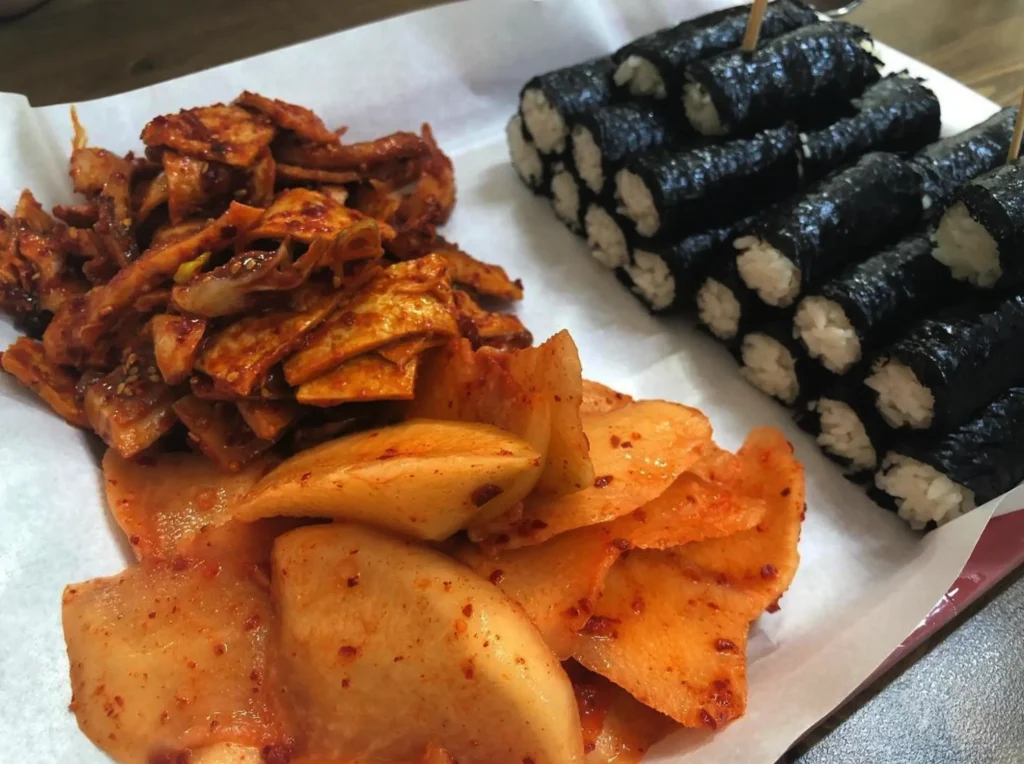1. Introduction to Chungmu-Kimbap
Chungmu Kimbap is a type of kimbap that originated from Chungmu, the old name of Tongyeong City in South Korea.
2. What is Chungmu-Kimbap
Chungmu Kimbap is a distinctive Korean culinary offering, primarily comprising petite-sized kimbap rolls filled solely with rice, accompanied by seokbakji (mixed radish kimchi), and a choice between stir-fried fish cakes or marinated squid. This dish diverges notably from traditional kimbap in its consumption method. It is customary to skewer a piece of the small kimbap, radish kimchi, and squid together, allowing for a harmonious blend of flavors in a single bite. However, diners may also choose to enjoy each component separately, based on personal taste preferences. Typically, Chungmu Kimbap is served alongside a soup made from dried radish greens(Siraegi), adding a complementary flavor profile to the meal.
3. Story about Chungmu-Kimbap
The origins of Chungmu Kimbap, a unique Korean culinary item, are subject to two primary theories. The first posits that its creation dates back to post-liberation Korea in 1945, specifically in Tongyeong City, historically known as Chungmu City. This era saw a significant number of individuals venturing into the sea for fishing. Given the absence of refrigeration facilities on boats at the time, there was a necessity for food that could be preserved for extended periods. This led to the development of a simple kimbap, consisting solely of rice, accompanied by radish kimchi and various seasoned side dishes, which became a staple among seafarers. The second theory suggests that Chungmu Kimbap originated due to Tongyeong City’s status as a bustling maritime hub. The city’s constant flow of people prompted local merchants to create and sell food that could withstand long periods without refrigeration. This need gave rise to what is now recognized as Chungmu Kimbap. While the true origin remains uncertain, both theories converge on the point that Chungmu Kimbap was designed for consumption without the need for refrigeration, distinguishing it from traditional kimbap and leading to its popularity across South Korea.
Several establishments in Tongyeong lay claim to being the original purveyors of Chungmu Kimbap. However, ‘Hanil'(한일), ‘Tongyeong Halmae'(통영 할매), and ‘Ddungbo Halmae'(뚱뽀 할매) are widely acknowledged as the forerunners in its sale. Initially, these three operated as a single entity before eventually dividing into separate entities for reasons unknown. Each establishment is renowned for specific components of the dish; ‘Hanil’ is particularly noted for its mixed radish kimchi and seasoned squid, while ‘Tongyeong Halmae’ is celebrated for its dried radish green soup.
Chungmu Kimbap’s journey to national recognition in South Korea began with its introduction at the ‘Gukpung 81‘ festival in 1981. The dish, presented by an individual named ‘Eodu-i’, quickly garnered widespread acclaim. However, as Chungmu Kimbap made its way to Seoul, subtle changes in its flavor profile were observed. The Seoul version of the seasoned squid in Chungmu Kimbap deviated from its original recipe, favoring a sweeter taste over the traditional spiciness.

3. What Koreans Really Think About Chungmu-Kimbap
In recent times, Chungmu Kimbap’s reputation in South Korea has seen a decline. Historically, this dish was celebrated as a staple among the masses, known for its satisfying portions at a modest price. Presently, however, it neither boasts generous quantities nor a particularly distinctive flavor profile, yet it has paradoxically become associated with a higher price tag. From an objective standpoint, Chungmu Kimbap is a straightforward dish to prepare, not necessitating any advanced culinary skills, yet it commands a premium in the market. A standard serving size often falls short for an average adult male, typically requiring about two portions to be sufficiently satiating.
The root of this controversy can often be traced back to comparisons with traditional kimbap. On average, Chungmu Kimbap is priced approximately 1.5 times higher than regular kimbap. The escalating costs of seafood ingredients like squid are frequently cited to justify this price hike, a rationale that many consumers find difficult to accept.
Additionally, the current market offers a variety of other culinary options in a similar price bracket that are perceived to be more flavorful and filling, leading to Chungmu Kimbap being increasingly sidelined by Korean consumers. The situation is exacerbated by a lack of initiative to adapt or modify the dish; instead, there is a trend of increasing prices and decreasing portion sizes, further alienating consumers. Nonetheless, for those who have yet to experience Chungmu Kimbap, it may still be worth a try, as it undeniably provides a taste distinct from that of regular kimbap.